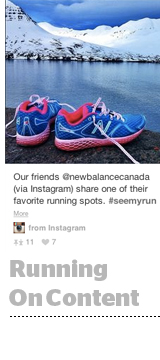 New Balance sells sneakers and sports apparel, but the brand is not all about chasing the transaction.
New Balance sells sneakers and sports apparel, but the brand is not all about chasing the transaction.
The Boston-based footwear manufacturer, which competes with names like Nike, Under Armour and Adidas, instead seeks to differentiate by pushing stories, not products.
As such, it faces a unique challenge in combining content and commerce.
“We hear these stories all the time,” Patrick Cassidy, global digital brand marketing director for New Balance, told AdExchanger. “There are times when you want to engage a consumer to buy now, especially around new product releases. But it’s also important to build a connection one wouldn’t expect from a global brand.”
One way it ensures success is by refraining from planning earned, owned and paid media in a vacuum. New Balance obsesses over “content, copy, time of day, colors, what part of the world is on ‘X’ platform when we launch,” Cassidy noted in a 2016 Retail Predictions report last month by Scratch Marketing and Media and QuickPivot.
Like any news organization, you have an editorial calendar with planned content and features for structure, but you want to be nimble enough to react in real time to the unexpected news of the day.
New Balance has the usual stable of digital, media and creative agencies who have the “firepower” to take ideas and campaign briefs to the next level, but has augmented those partners with a growing in-house team.
It directly employs seven staffers who focus on social distribution and content.
“Our mantra is obsessing over what content works best and when, and doing that with agility,” said Cassidy, who co-founded the basketball news publisher Dime magazine prior to joining New Balance; the magazine has since been acquired by UPROXX. “We’re trying to make the first and best impression on our owned [properties], but then social media is tier zero for audience engagement.”
One example was a #SeeMyRun campaign it launched with independent Boston agency Almighty last spring. The initiative tracked 22 runners’ everyday or competitive runs through digital videos they would shoot with a GoPro and share on Instagram or Facebook.
New Balance is seeking ways to layer in a paid strategy on top of organic content such as the videos, to create what he calls “micro-moments” that reach larger audiences.
“There’s this added complexity where it’s pay-to-play on most of these platforms,” he said. “The day of free, organic fun on Instagram is about to be over for a lot of brands.”
New Balance has considerable focus on digital, particularly with its digital rewards program and mobile app MyNB, but the brand also operates 200 brick-and-mortar stores. In some places, such as Chicago, individual stores have their own local marketing budgets.
Among other placements, the brand has leveraged Facebook Custom Audiences and Facebook Offers to reach subsets of shoppers who may be running the Chicago Marathon and are near a New Balance store.
In another targeted effort, New Balance has messaged members of the military and veterans by targeting “American heroes” in the Chicago area with a 15% off discount. And it has tailored creative and offers around weather in a given region (20% off in-store if the weather dropped below zero; otherwise, 15% off).
Measurement is key, though easier on some platforms than others. (“How do you really track the impact of a Snapchat video until the time that consumer went to the store?” Cassidy said).
“Each piece of content we put out every single day has a specific purpose, and the data tells us if that’s working or not working with what customer,” said Cassidy. “Social media is influencing what the rest of the org is doing on a daily basis.”













